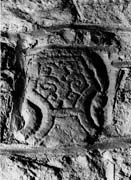Select a site alphabetically from the choices shown in the box below. Alternatively, browse sculptural examples using the Forward/Back buttons.
Chapters for this volume, along with copies of original in-text images, are available here.
Object type: Cross-arm [1]
Measurements: H. 23 cm (9 in); W. 16.5 > 12.5 cm (6.5 > 5 in); D. Built in
Stone type: Medium-grained, non-calcareous, yellow (10YR 8/6) sandstone; deltaic channel sandstone, Saltwick Formation, Aalenian, Middle Jurassic; from North Yorkshire Moors?
Plate numbers in printed volume: 506
Corpus volume reference: Vol 3 p. 151-152
(There may be more views or larger images available for this item. Click on the thumbnail image to view.)
Only one face is visible.
A (broad): One complete arm, type C12, of a free-armed cross-head, with circular arm-pits and chamfered sides. The section of the double plain edge moulding is lightly humped, and the inner moulding crosses the neck, forming an undecorated panel towards the centre of the cross-head. The panel formed in the arm contains a symmetrical, leafless tree-scroll, with tight spiral tendrils.
Collingwood considered this fragment to be a very late piece: 'the very latest pre-Conquest period' (1915, 259), and even '. . . made within the earlier part of the twelfth century.' (idem 1927, 175). This assumption is based on Collingwood's belief that the chamfered cross-arm was a late evolutionary form and that Anglian tree scrolls of such primitve appearance were survival elements in the Anglo-Norman overlap period. There are chamfered cross-arms carrying a wide variety of decorative motifs and it is unlikely that this shape serves as a reliable dating criterion; compare Collingwood's examples from Carlisle and Kirkdale, for example. Local variants and individual sculptors' styles are not taken into account.
The simple tree scroll fills a very small panel and there is not much room for elaboration. The absence of leaves and buds does reflect taste of the Anglo-Scandinavian period, as does the circular arm-pit.



